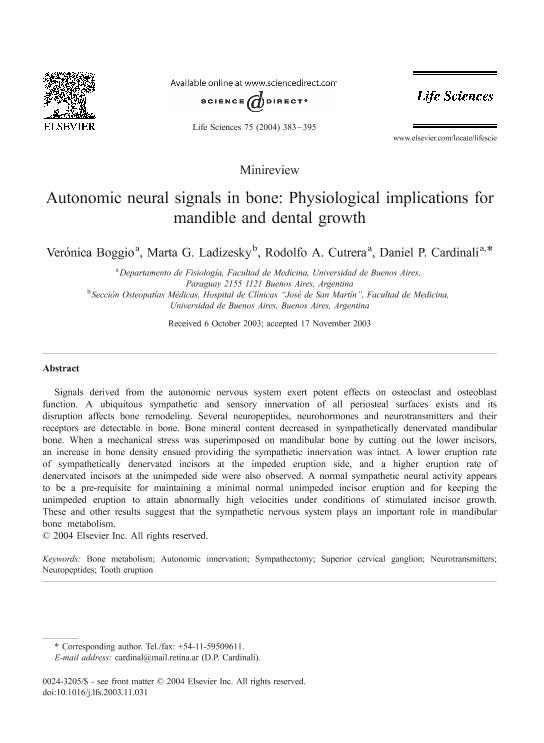Mostrar el registro sencillo del ítem
dc.contributor.author
Boggio, Veronica Ines

dc.contributor.author
Ladizesky, Marta Graciela

dc.contributor.author
Cutrera, Rodolfo Angel

dc.contributor.author
Cardinali, Daniel Pedro

dc.date.available
2022-07-20T11:31:24Z
dc.date.issued
2004-06
dc.identifier.citation
Boggio, Veronica Ines; Ladizesky, Marta Graciela; Cutrera, Rodolfo Angel; Cardinali, Daniel Pedro; Autonomic neural signals in bone: Physiological implications for mandible and dental growth; Pergamon-Elsevier Science Ltd; Life Sciences; 75; 4; 6-2004; 383-395
dc.identifier.issn
0024-3205
dc.identifier.uri
http://hdl.handle.net/11336/162607
dc.description.abstract
Signals derived from the autonomic nervous system exert potent effects on osteoclast and osteoblast function. A ubiquitous sympathetic and sensory innervation of all periosteal surfaces exists and its disruption affects bone remodeling. Several neuropeptides, neurohormones and neurotransmitters and their receptors are detectable in bone. Bone mineral content decreased in sympathetically denervated mandibular bone. When a mechanical stress was superimposed on mandibular bone by cutting out the lower incisors, an increase in bone density ensued providing the sympathetic innervation was intact. A lower eruption rate of sympathetically denervated incisors at the impeded eruption side, and a higher eruption rate of denervated incisors at the unimpeded side were also observed. A normal sympathetic neural activity appears to be a pre-requisite for maintaining a minimal normal unimpeded incisor eruption and for keeping the unimpeded eruption to attain abnormally high velocities under conditions of stimulated incisor growth. These and other results suggest that the sympathetic nervous system plays an important role in mandibular bone metabolism.
dc.format
application/pdf
dc.language.iso
eng
dc.publisher
Pergamon-Elsevier Science Ltd

dc.rights
info:eu-repo/semantics/openAccess
dc.rights.uri
https://creativecommons.org/licenses/by-nc-sa/2.5/ar/
dc.subject
AUTONOMIC INNERVATION
dc.subject
BONE METABOLISM
dc.subject
NEUROPEPTIDES
dc.subject
NEUROTRANSMITTERS
dc.subject
SUPERIOR CERVICAL GANGLION
dc.subject
SYMPATHECTOMY
dc.subject
TOOTH ERUPTION
dc.subject.classification
Fisiología

dc.subject.classification
Medicina Básica

dc.subject.classification
CIENCIAS MÉDICAS Y DE LA SALUD

dc.title
Autonomic neural signals in bone: Physiological implications for mandible and dental growth
dc.type
info:eu-repo/semantics/article
dc.type
info:ar-repo/semantics/artículo
dc.type
info:eu-repo/semantics/publishedVersion
dc.date.updated
2022-07-15T15:23:39Z
dc.journal.volume
75
dc.journal.number
4
dc.journal.pagination
383-395
dc.journal.pais
Estados Unidos

dc.description.fil
Fil: Boggio, Veronica Ines. Consejo Nacional de Investigaciones Científicas y Técnicas; Argentina. Universidad de Buenos Aires. Facultad de Medicina; Argentina
dc.description.fil
Fil: Ladizesky, Marta Graciela. Universidad de Buenos Aires. Facultad de Medicina. Hospital de Clínicas General San Martín; Argentina. Consejo Nacional de Investigaciones Científicas y Técnicas; Argentina
dc.description.fil
Fil: Cutrera, Rodolfo Angel. Universidad de Buenos Aires. Facultad de Medicina; Argentina. Consejo Nacional de Investigaciones Científicas y Técnicas; Argentina
dc.description.fil
Fil: Cardinali, Daniel Pedro. Universidad de Buenos Aires. Facultad de Medicina; Argentina. Consejo Nacional de Investigaciones Científicas y Técnicas; Argentina
dc.journal.title
Life Sciences

dc.relation.alternativeid
info:eu-repo/semantics/altIdentifier/url/https://www.sciencedirect.com/science/article/abs/pii/S0024320504002401
dc.relation.alternativeid
info:eu-repo/semantics/altIdentifier/doi/http://dx.doi.org/10.1016/j.lfs.2003.11.031
Archivos asociados
